六年级谓语动词第三人称单数
六年级英语动词第三人称单数完形填空题50题

六年级英语动词第三人称单数完形填空题50题1My friend Lily is a student. She __1__ to school by bus every day. Her teacher, Miss Wang, __2__ very kind. Lily __3__ many friends at school. They often play games together. After school, Lily __4__ her homework first. Then she __5__ TV or reads books.1. A. go B. goes C. going D. went答案:B。
Lily 是第三人称单数,谓语动词要用goes。
go 的第三人称单数形式是goes。
2. A. is B. are C. am D. be答案:A。
Miss Wang 是第三人称单数,be 动词用is。
3. A. have B. has C. having D. had答案:B。
Lily 是第三人称单数,have 要用has。
4. A. do B. does C. doing D. did答案:B。
Lily 是第三人称单数,do 的第三人称单数形式是does。
5. A. watch B. watches C. watching D. watched答案:B。
she 是第三人称单数,watch 要用watches。
2My friend Lily is a student. She has many activities at school. Every day, she gets up early and ___11___ breakfast quickly. Then she goes to school. In class, she ___12___ carefully and takes notes. After school, sheplays basketball with her friends. She ___13___ basketball very well.11. A. has B. have C. having D. to have答案:A。
动词第三人称单数的变化规则
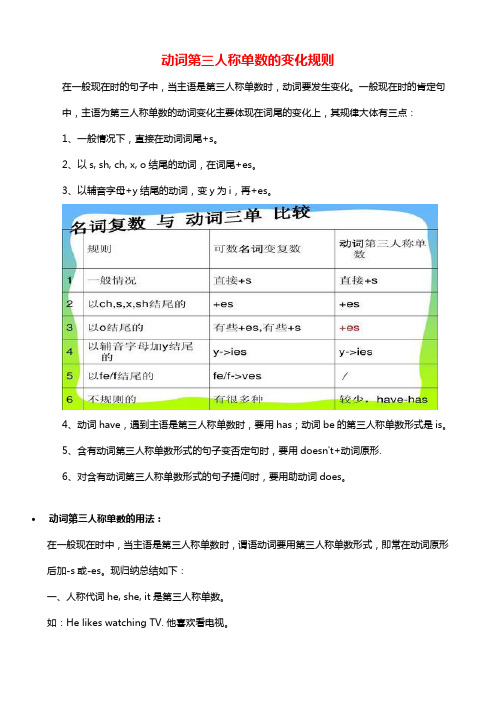
动词第三人称单数的变化规则在一般现在时的句子中,当主语是第三人称单数时,动词要发生变化。
一般现在时的肯定句中,主语为第三人称单数的动词变化主要体现在词尾的变化上,其规律大体有三点:1、一般情况下,直接在动词词尾+s。
2、以s, sh, ch, x, o结尾的动词,在词尾+es。
3、以辅音字母+y结尾的动词,变y为i,再+es。
4、动词have,遇到主语是第三人称单数时,要用has;动词be的第三人称单数形式是is。
5、含有动词第三人称单数形式的句子变否定句时,要用doesn't+动词原形.6、对含有动词第三人称单数形式的句子提问时,要用助动词does。
•动词第三人称单数的用法:在一般现在时中,当主语是第三人称单数时,谓语动词要用第三人称单数形式,即常在动词原形后加-s或-es。
现归纳总结如下:一、人称代词he, she, it是第三人称单数。
如:He likes watching TV. 他喜欢看电视。
She has lunch at twelve. 她十二点吃午餐。
It looks like a cat. 它看起来像只猫。
二、单个人名、地名或称呼作主语;是第三人称单数。
如:①HanMei looks like her mother. 韩梅看起来像她的母亲。
②Beijing is in China. 北京在中国。
③UncleWang often makes cakes. 王叔叔经常做蛋糕。
三、单数可数名词或"this/that/the+单数可数名词"作主语时,是第三人称单数。
如:①A horse is a useful animal.马是有用的动物。
②This book is yours.这本书是你的。
③That car is red.那辆小汽车是红色的。
④The cat is Lucy's.这只猫是露茜的。
四、不定代词someone, somebody, nobody, everything, something等及指示代词this, that 作主语时,是第三人称单数。
六年级谓语动词第三人称单数

ch, sh, x, o, s,动词结尾-es;
★第三人称单数动词的变化规则
③ 以辅音字母加y结尾的动词,先变y为i,再加 -es;
study --- studies fly --- flies
worry --- worries try ---tries
stays ( stay ) at home in
5. The students fly ( fly ) kites on weekends.
6. Zhaoqing
is
( be ) a beautiful city.
一般现在时(The simple present tense)
★第三人称单数动词的变化规则
• The boy studies (study) English on Mondays. • It has (have) a big mouth.
★第三人称单数动词的变化规则
① 一般情况下,动词词尾直接加-s;
work --- works play --- plays
look --- looks feel ---feels
Let’s have a try.
1. My sister often catches ( catch ) butterflies.
2. He go es ( go ) swimming with his friends.
3. Andy has ( have ) a white cat.
4. Uncle Bill usually the evening.
一般现在时,主语三单变动词; 通常词尾加-s,除了have变has; ch, sh, x, o, s,动词结尾-es; 辅音字母 y 结尾,改y为i –es。
小学六年级英语动词的第三人称单数知识讲解
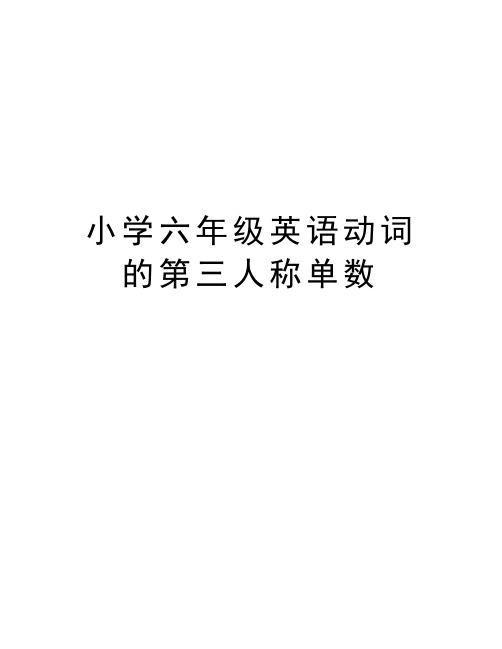
小学六年级英语动词的第三人称单数小学英语语法:“第三人称单数”第三人称有“他、她、它以及一些单数名词”。
当主语是第三人称单数时,谓语动词要用第三人称单数形式,即常在动词原形后加-s或-es。
一、动词第三人称单数的变化规则及发音规律动词原形变第三人称单数的规则与发音规律同名词单数变复数大致相同,请认真观察。
1、大多数动词在词尾加“S”如:stop-stops [s] ; make-makes [s] read-reads [z] ; play-plays [z]2、以辅音字母加“y”结尾的,要先将“y”变为“i”,然后在加“es”读[iz] 如:fly-flies [z]; carry-carries [z] study-studies [z]; worry-worries3、以“s, x, ch, sh”结尾的,在词尾加“es”,发音为[iz] 如:teach-teaches [iz]; watch-watches [iz]4、以“o”结尾的动词,加“es”,如:go-goes [z] do-does [z]注:下面几个动词变为单数时,原词的元音部分的发音发生了较大的变化,请注意记忆。
如:do [du:]-does [dz] say [sei]-says [sez]以不发音字母“e”结尾的开音节词,如果尾音是[s],[z]时,加“s”后字母“e”发音,与所加“s”一起读做[iz]。
如:close-closes [iz]一、第三人称代词 he, she, it 做主语时。
例如:She is very good at English. 她英语学得好。
He studies in a middle school. 他在一所中学学习。
He likes watching TV. 他喜欢看电视。
She has lunch at twelve. 她十二点吃午餐。
He can play football. 他会踢足球。
第三人称单数总结

第三人称单数总结一、定义在一般现在时中,当主语是第三人称单数时,即主语为“它/他/她”时,谓语动词要用第三人称单数形式,一般规律是在动词原形后加s或者es。
二、变化规则(一)一般情况:大多数动词都是直接在原形后+s,例:come-comes keep-keeps(二)以s、x、ch、sh和o结尾时,在动词原形后+es,例:pass-passes fix-fixes teach-teaches go-goes(三)以辅音字母+y结尾的动词,变y为i+es,例:try-tries study-studies(四)以元音字母+y结尾的动词,直接在动词后+s,例:play-plays(五)特殊情况:动词have,遇到主语是第三人称单数时,变have为has;be动词的第三人称单数形式是is。
三、用法简单概括就是,在一般现在时的时态中,当句子的主语是第三人称单数时,谓语动词要用第三人称单数形式。
具体用法有以下几种情况:(一)遇到人称代词it、he、she时:例:It looks nice. 它看起来很漂亮。
He often has breakfast at seven. 他经常在早上七点吃早餐。
She likes dancing. 她喜欢跳舞。
(二)单个人名、地名或称呼作主语时:例:Li Lei looks like his father. 李雷看起来像他爸爸。
Fu jian is in China. 福建在中国。
Uncle Zhan often makes cakes. 詹叔叔经常做蛋糕。
(三)单数可数名词或“this/that/the+单数可数名词”作主语时:例:An apple is on the desk. 有一个苹果在桌上。
This car is black. 这辆车是黑色的。
That book is yours. 那本书是你的。
The cat looks so cute. 这只猫看起来真可爱。
六年级下册英语专项练习动词第三人称单数的变化规则 全国通用-精选教育文档
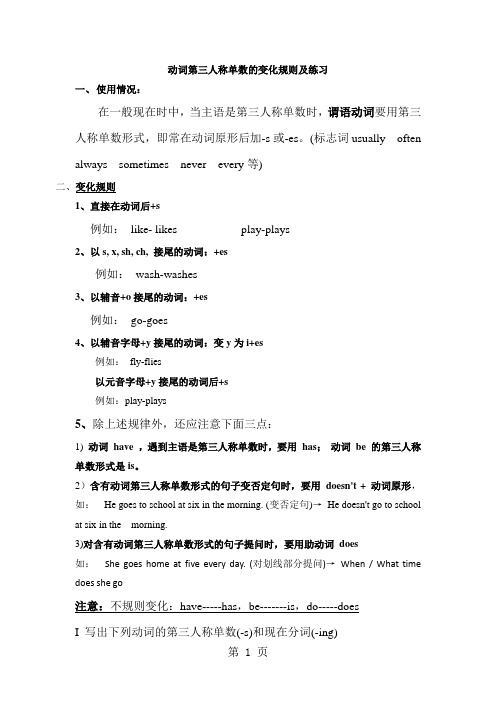
动词第三人称单数的变化规则及练习一、使用情况:在一般现在时中,当主语是第三人称单数时,谓语动词要用第三人称单数形式,即常在动词原形后加-s或-es。
(标志词usually often always sometimes never every等)二、变化规则1、直接在动词后+s例如:like- likes play-plays2、以s, x, sh, ch, 接尾的动词:+es例如:wash-washes3、以辅音+o接尾的动词:+es例如:go-goes4、以辅音字母+y接尾的动词:变y为i+es例如:fly-flies以元音字母+y接尾的动词后+s例如:play-plays5、除上述规律外,还应注意下面三点:1)动词have ,遇到主语是第三人称单数时,要用has;动词be 的第三人称单数形式是is。
2)含有动词第三人称单数形式的句子变否定句时,要用doesn't + 动词原形,如:He goes to school at six in the morning. (变否定句)→He doesn't go to school at six in the morning.3)对含有动词第三人称单数形式的句子提问时,要用助动词does如:She goes home at five every day. (对划线部分提问)→When / What time does she go注意:不规则变化:have-----has,be-------is,do-----doesI 写出下列动词的第三人称单数(-s)和现在分词(-ing)go do play jump swim run put sing dance come get have fly study read write look drink eat walk like II选择1.Ben_____a new book.A. haveB. hasC. havesD. were2.Ben and Mary some books.A. haveB. hasC. areD. were3.I some stories every day.A. haveB. hasC. areD. were4.I __________ ice cream.A.likeB.likesC.likingD.likees5. Kitty__ English every dayA.readB.readesC.readingD.reads6.A man _____in front of his car.A.walkB.walksC.walkingD.work7.Sam’s bicycle ______a bell.A.have B has C.having D.is having8.I every dayA.swimB.swimsC.swimingD.swimes9.He his homework every day.A.doesB.doC.areD.is10. I ________ my homework every day.A.doB.isC.doesD.are11.They ________ their homework every day.A. doB.doesC. isD.are11.Lucy_______with her hands.A.touchB.touchingC.touchesD.touchs12.Superdog________the boysA.seeB.seesC.seeingD.ses13.Supergirl and Superdog______them.A.savesB.saveC.savingD.is saving14.Jack_______their cow.A.sellsB.sellC.sellingD.are selling15.Jack______up the beanstalk.A.getsB.getC.climbD.climbs16.The giant ______boys.A.eatingB.don’t eatC.eatsD.eat17.The goose_______golden eggs.yysyedyes17.The woman_______the beanstalk.A.cutB.cuttingC.are cutD.cuts18.Her mother ______the beanstalk.A.takeB.is take Ctakes D. taking19Jack andher mother _____happerA.doesB.areC.isD. have20.He____the beans in the ground.A.buyB.putsC.putD.buys二.填空:1.She ______(do) homework by herself.2.Jack ______(go) home by bike.3.The giant______(climb) up the beanstalk.4.Her mum ______(run) to the goose.5.He______(do not)like apple.6,Sam______(put) it under his arm.7.The boy_______(chase) it.8.Kitty______(watch)TV everyday.9.He______(feed)them at 8:00 in the morning.10.When ______(do)he get up?11.Grandma Wang___(live) in Pudong.12.The girls___(give) the key to Grandpa.13.That key ______(open) the old box.14.She ______(say) “I like these puppets”.15.What_____(do)Alice find?16.Which toy_____(do) she like?17.He doesn’t______(know)her name.18.John can’t_______(find) his watch.19.Where _____(do)Grandma live?20.How does he______(go)to the post office?三、请看下面两组句子,注意区分他们的共同点和不同点。
小学英语动词第三人称单数形式用法详解

般现在时中的第三人称单数形式在一般现在时中,当主语是第三人称单数时,谓语动词要用第三人称单数形式,形后加-s或-es。
(一)什么是一般现在时?一般现在时的基本用法有哪些呢?【一般现在时的功能】1. 表示事物或人物的特征、状态。
如:The sky is blue.天空是蓝色的。
2. 表示经常性或习惯性的动作。
如:I get up at six every day.我每天六点起床。
标志词(时间状语):always, every week (day, year, month …),once a week, every …,sometimes, at …,on Sun day uausllyoften,never,hardly.........3. 表示客观现实。
如:The earth goes around the sun.地球绕着太阳转。
(二)哪些主语是第三人称单数?现归纳总结如下:、单个人名、地名或称呼作主语;是第三人称单数。
如:①Han Mei looks like her mother. 韩梅看起来像她的母亲。
②Beiji ng is in Chi na. 北京在中国。
即常在动词原人称代词he, she, itHe likes watch ing TV. he has lunch at twelve. It looks like a cat. 是第三人称单数。
如:他喜欢看电视。
她十二点吃午餐。
它看起来像只猫。
③Uncle Wang ofte n makes cakes. 王叔叔经常做蛋糕。
① A horse is a useful animal.四、不定代词 someone, somebody, nobody, everything, something that 作主语时,是第三人称单数。
如:① Everyone is here. 大家到齐了。
② There is something wrong with the watch.③ This is a pen. 这是一支钢笔。
谓语动词何时使用第三人称单数

谓语动词何时使用第三人称单数在一般现在时态中,当谓语动词为be动词时有三种形式:am, is, are;当谓语动词为行为(实义)动词时有两种形式:动词原形和动词的第三人称单数形式(均以肯定句为标准)。
谓语动词使用第三人称单数的六种情况:一、主语为人称代词he, she或it时。
如:He is a car driver. She teaches us English. It looks like a bird.二、主语为指示代词this或that时。
如:This is mine. That shows(表明)you are right.三、主语为单数可数名词时。
如:My brother is twelve.His friend has many books.The teacher stands there.四、主语为单个的人名或称呼语或地名时。
如:Tom works in a factory near here.Mr. White is a worker.London is a big city.五、主语为不可数名词时。
如:The milk is in the bottle.There is some orange juice in the glass.六、数字单独作主语或表示加减运算时,动词要用第三人称单数。
如:“6” is a good number. 六是一个吉利数。
Three plus two is five. 三加二等于五。
do的用法例析错例1He does his homework in the evening.(改为否定句和一般疑问句)1.He doesn’t his homework in the evening.2.Does he his homework in the evening?分析:do既可作助动词,又可作实义动词。
在肯定句中作实义动词时,不论以do还是以does的形式出现,变成否定句或一般疑问句时,都要先加一个助动词do/does,而不是在实义动词do之后加not或把do提到句首;加上助动词之后,do要用原形。
第三人称单数的用法
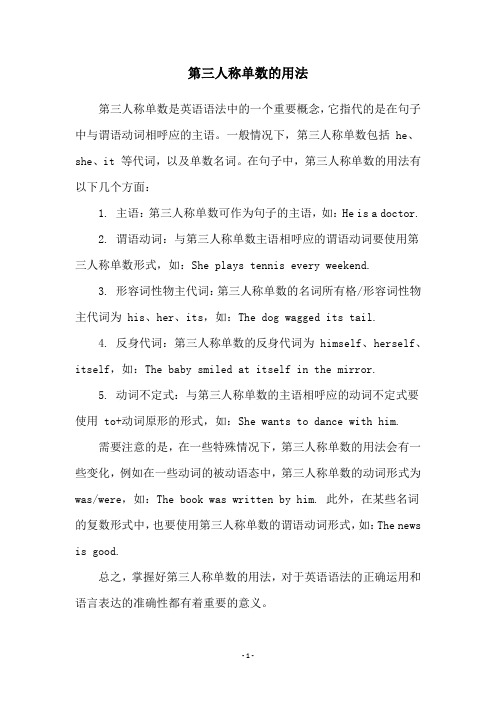
第三人称单数的用法
第三人称单数是英语语法中的一个重要概念,它指代的是在句子中与谓语动词相呼应的主语。
一般情况下,第三人称单数包括 he、she、it 等代词,以及单数名词。
在句子中,第三人称单数的用法有以下几个方面:
1. 主语:第三人称单数可作为句子的主语,如:He is a doctor.
2. 谓语动词:与第三人称单数主语相呼应的谓语动词要使用第三人称单数形式,如:She plays tennis every weekend.
3. 形容词性物主代词:第三人称单数的名词所有格/形容词性物主代词为 his、her、its,如:The dog wagged its tail.
4. 反身代词:第三人称单数的反身代词为 himself、herself、itself,如:The baby smiled at itself in the mirror.
5. 动词不定式:与第三人称单数的主语相呼应的动词不定式要使用 to+动词原形的形式,如:She wants to dance with him.
需要注意的是,在一些特殊情况下,第三人称单数的用法会有一些变化,例如在一些动词的被动语态中,第三人称单数的动词形式为was/were,如:The book was written by him. 此外,在某些名词的复数形式中,也要使用第三人称单数的谓语动词形式,如:The news is good.
总之,掌握好第三人称单数的用法,对于英语语法的正确运用和语言表达的准确性都有着重要的意义。
- 1 -。
动词第三人称单数的变化规则及练习
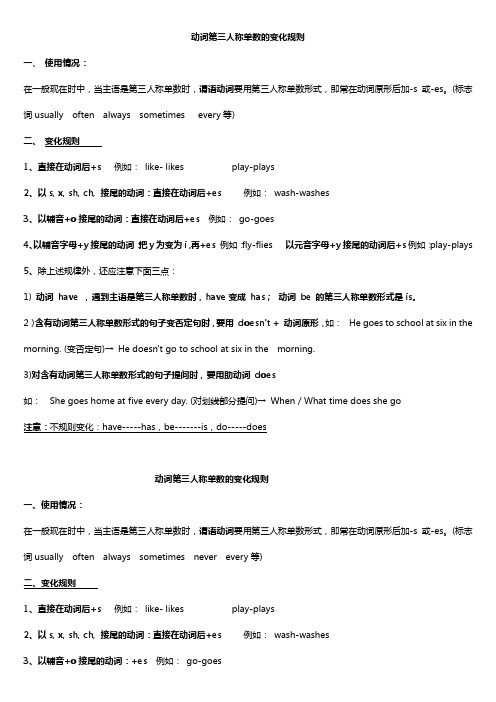
动词第三人称单数的变化规则一、使用情况:在一般现在时中,当主语是第三人称单数时,谓语动词要用第三人称单数形式,即常在动词原形后加-s或-es。
(标志词usually often always sometimes every等)二、变化规则1、直接在动词后+s 例如:like- likes play-plays2、以s, x, sh, ch, 接尾的动词:直接在动词后+es 例如:wash-washes3、以辅音+o接尾的动词:直接在动词后+es 例如:go-goes4、以辅音字母+y接尾的动词:把y为变为i,再+es 例如:fly-flies 以元音字母+y接尾的动词后+s例如:play-plays5、除上述规律外,还应注意下面三点:1)动词have ,遇到主语是第三人称单数时,have变成has;动词be 的第三人称单数形式是is。
2)含有动词第三人称单数形式的句子变否定句时,要用doesn't + 动词原形,如:He goes to school at six in the morning. (变否定句)→He doesn't go to school at six in the morning.3)对含有动词第三人称单数形式的句子提问时,要用助动词does如:She goes home at five every day. (对划线部分提问)→When / What time does she go注意:不规则变化:have-----has,be-------is,do-----does动词第三人称单数的变化规则一、使用情况:在一般现在时中,当主语是第三人称单数时,谓语动词要用第三人称单数形式,即常在动词原形后加-s或-es。
(标志词usually often always sometimes never every等)二、变化规则1、直接在动词后+s 例如:like- likes play-plays2、以s, x, sh, ch, 接尾的动词:直接在动词后+es 例如:wash-washes3、以辅音+o接尾的动词:+es 例如:go-goes4、以辅音字母+y接尾的动词:把y变为i,再+es 例如:fly-flies 以元音字母+y接尾的动词后+s例如:play-plays5、除上述规律外,还应注意下面三点:1)动词have ,遇到主语是第三人称单数时,have变成has;动词be 的第三人称单数形式是is。
小学六年级上第三人称单数专项讲解
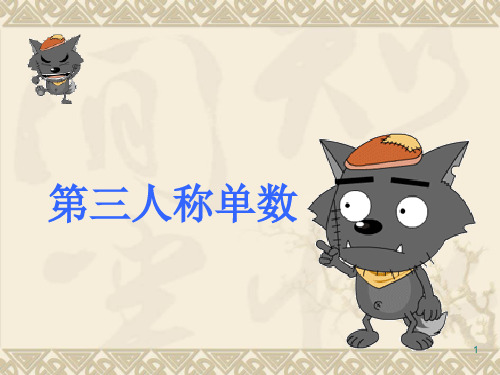
15
swim
swims
She swims
after school.
16
read
reads
He reads
books everyday.
17
play football
plays football
He plays football very well.
3
第三人称单数动词变化的运用条件:
2. 主语为第三人称单数,单数名词当主语时 eg. She, he, it, Lucy, Kate, Li Ming. 3. 主语是不可数名词时 eg. Meat is in that plate. 肉在那个盘子里面。 4. 不定代词someone, somebody, nobody, everything, something及this, that作主语时 eg. Everyone is here. That is mine.
26
1.Ben_____a new bicycle. A.have B.has C.are D.were 2.Kitty_____her bicycle to the park. A.ride B.riding C.rides D.ridden 3.A man _____in front of his car. A.walk B.walks C.walking D.work 4.Sam’s bicycle ______a bell. A.have B has C.having D.is having 5.The girl _______ “Excuse me” A.say B.saying C.says D.sayes
11
动词第三人称单数
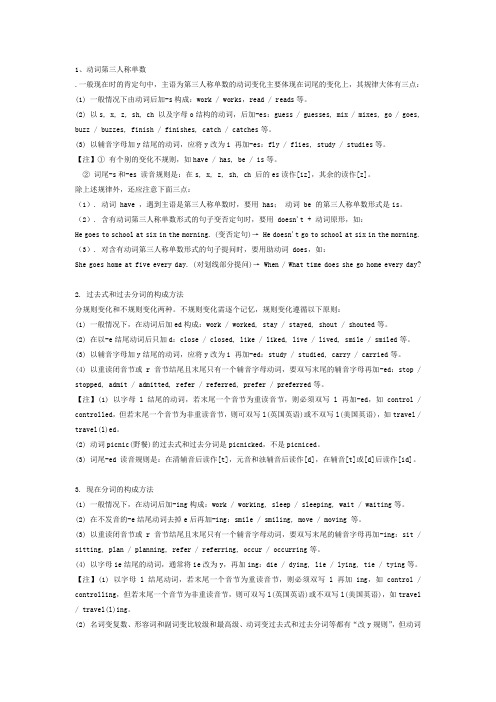
1、动词第三人称单数.一般现在时的肯定句中,主语为第三人称单数的动词变化主要体现在词尾的变化上,其规律大体有三点:(1) 一般情况下由动词后加-s构成:work / works,read / reads等。
(2) 以s, x, z, sh, ch 以及字母o结构的动词,后加-es:guess / guesses, mix / mixes, go / goes, buzz / buzzes, finish / finishes, catch / catches等。
(3) 以辅音字母加y结尾的动词,应将y改为i 再加-es:fly / flies, study / studies等。
【注】①有个别的变化不规则,如have / has, be / is等。
②词尾-s和-es 读音规则是:在s, x, z, sh, ch 后的es读作[iz],其余的读作[z]。
除上述规律外,还应注意下面三点:(1). 动词 have ,遇到主语是第三人称单数时,要用 has;动词 be 的第三人称单数形式是is。
(2). 含有动词第三人称单数形式的句子变否定句时,要用 doesn't + 动词原形,如:He goes to school at six in the morning. (变否定句)→ He doesn't go to school at six in the morning. (3). 对含有动词第三人称单数形式的句子提问时,要用助动词 does,如:She goes home at five every day. (对划线部分提问)→ When / What time does she go home every day?2. 过去式和过去分词的构成方法分规则变化和不规则变化两种。
不规则变化需逐个记忆,规则变化遵循以下原则:(1) 一般情况下,在动词后加ed构成:work / worked, stay / stayed, shout / shouted等。
动词第三人称单数形式的使用条件及变化规律

动词第三人称单数形式的使用条件及变化规律在一般现在时中,当主语是第三人称单数时,谓语动词要用第三人称单数形式,即常在动词原形后加-s或-es。
但有些同学们对于哪些主语是第三人称单数还不十分清楚,现归纳总结如下:一、人称代词he, she, it是第三人称单数。
如:He likes watching TV. 他喜欢看电视。
She has lunch at twelve. 她十二点吃午餐。
It looks like a cat. 它看起来像只猫。
二、单个人名、地名或称呼作主语;是第三人称单数。
如:①Han Mei looks like her mother. 韩梅看起来像她的母亲。
②Beijing is in China. 北京在中国。
③Uncle Wang often makes cakes. 王叔叔经常做蛋糕。
三、单数可数名词或"this / that / the+单数可数名词"作主语时,是第三人称单数。
如:①A horse is a useful animal. 马是有用的动物。
②This book is yours. 这本书是你的。
③That car is red. 那辆小汽车是红色的。
④The cat is Lucy's. 这只猫是露茜的。
四、不定代词someone, somebody, nobody, everything, something等及指示代词this,that作主语时,是第三人称单数。
如:①Everyone is here. 大家到齐了。
②There is something wrong with the watch. 这块手表有毛病。
③This is a pen. 这是一支钢笔。
④That is an eraser. 那是一块橡皮擦。
五、不可数名词作主语时为第三人称单数。
如:①The milk is in the glass. 牛奶在玻璃杯里。
六年级英语上册第三人称单数主语的六种形式

第三人称单数主语的六种形式大家都知道,在一般现在时中,当主语是第三人称单数时,谓语动词要用第三人称单数形式,即常在动词原形后加-s或-es。
但有些同学们对于哪些主语是第三人称单数还不十分清楚,现归纳总结如下:一、人称代词he, she, it是第三人称单数。
如:He likes watching TV. 他喜欢看电视。
She has lunch at twelve. 她十二点吃午餐。
It looks like a cat. 它看起来像只猫。
二、单个人名、地名或称呼作主语;是第三人称单数。
如:①Han Mei looks like her mother. 韩梅看起来像她的母亲。
②Beijing is in China. 北京在中国。
③Uncle Wang often makes cakes. 王叔叔经常做蛋糕。
三、单数可数名词或"this / that / the+单数可数名词"作主语时,是第三人称单数。
如:①A horse is a useful animal. 马是有用的动物。
②This book is yours. 这本书是你的。
③That car is red. 那辆小汽车是红色的。
④The cat is Lucy's. 这只猫是露茜的。
四、不定代词someone, somebody, nobody, everything, something等及指示代词this, that作主语时,是第三人称单数。
如:①Everyone is here. 大家到齐了。
②There is something wrong with the watch. 这块手表有毛病。
③This is a pen. 这是一支钢笔。
④That is an eraser. 那是一块橡皮擦。
五、不可数名词作主语时为第三人称单数。
如:①The milk is in the glass. 牛奶在玻璃杯里。
六年级英语句型转换
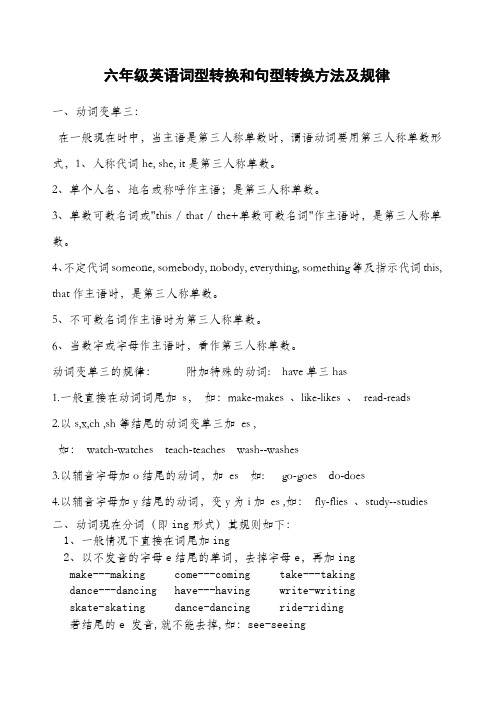
六年级英语词型转换和句型转换方法及规律一、动词变单三:在一般现在时中,当主语是第三人称单数时,谓语动词要用第三人称单数形式,1、人称代词he, she, it是第三人称单数。
2、单个人名、地名或称呼作主语;是第三人称单数。
3、单数可数名词或"this / that / the+单数可数名词"作主语时,是第三人称单数。
4、不定代词someone, somebody, nobody, everything, something等及指示代词this, that作主语时,是第三人称单数。
5、不可数名词作主语时为第三人称单数。
6、当数字或字母作主语时,看作第三人称单数。
动词变单三的规律:附加特殊的动词: have单三has1.一般直接在动词词尾加s,如:make-makes 、like-likes 、read-reads2.以s,x,ch ,sh等结尾的动词变单三加es ,如:watch-watches teach-teaches wash--washes3.以辅音字母加o结尾的动词,加es 如: go-goes do-does4.以辅音字母加y结尾的动词,变y为i加es ,如:fly-flies 、study--studies二、动词现在分词(即ing形式)其规则如下:1、一般情况下直接在词尾加ing2、以不发音的字母e结尾的单词,去掉字母e,再加ingmake---making come---coming take---takingdance---dancing have---having write-writingskate-skating dance-dancing ride-riding若结尾的e 发音,就不能去掉,如:see-seeing3、以重读闭音节结尾,呈现“辅,元,辅”结构的动词,先双写末尾的辅音字母,再加ingrun-running, swim-swimming, get – getting,sit–sitting, put–putting, begin–beginning(visit,listen重读在前 ,不是以重读闭音节结尾,不用双写,直接加ing)4、以ie结尾的动词,把ie改为y ,再加ingdie---dying lie---lying名词变复数规律:1.一般名词复数是在名词后面加上“s”2.以s, sh, ch, x等结尾的名词变复数加“es”,如bus→bus es, dish→dishes watch→watch es,box→box es,peach→peach es3.以辅音字母+y结尾的名词变复数,把y变i加es,如bab y→bab ies, countr y→countr ies,factory→factoriesdictionary→dictionaries, university→universitiessecretary →secretaries , librar y→librar ies,(以元音字母+ y结尾的名词变复数时,直接加s变复数,如monk e y→monkeys, holid a y→holiday s, b o y→boy s);4.以o 结尾的名词变复数时:a)常见加es的名词有:土豆potato→potato es; 西红柿tomato→tomato esb)常见加s的名词有:photo→photo s,piano→piano s,radio→radio s, zoo→zoo s5、以e结尾加s :shoe→ shoe s ; rule→ rule s, bike→bike s6.以f或fe结尾的名词变复数时:去掉f, fe 加ves的名词有:hal f→hal ves; kni fe→kni ves lea f→lea ves ; wi fe→wi vesli fe→li ves人称代词和物主代词:一、人称代词二、物主代词1.含有be动词(am, is, are) 或情态动词(can,may,must,should) 的句子变一般疑问句,首先将be动词或情态动词提到句首,然后改变大小写及标点符号。
六年级上册英语必考语法

六年级上册英语必考语法六年级上册英语必考语法点有很多,主要包括以下几个方面:1. 一般现在时:表示现在经常发生的动作或存在的状态。
其谓语动词的形式为“动词原形(第三人称单数)”。
如:I have a pencil. She has a ruler.2. 现在进行时:表示正在进行的动作或存在的状态。
其谓语动词的形式为“am/is/are + 动词-ing”。
如:I am writing a letter. They are playing basketball.3. 一般过去时:表示过去发生的动作或存在的状态。
其谓语动词的形式为“动词过去式”。
如:I wrote a letter yesterday. She visited her grandparents last weekend.4. 一般将来时:表示将来要发生的动作或存在的状态。
其谓语动词的形式为“will + 动词原形”。
如:I will go to the park tomorrow. They will have a party next week.5. 名词:表示人、事物、地点或抽象概念的名称。
如:dog、cat、apple、school等。
6. 冠词:用于修饰名词,表示该名词的类别。
如:a用于辅音音素开头的单词前,an用于元音音素开头的单词前。
如:a book、an apple。
7. 代词:用来代替名词,避免重复。
如:she、he、it、they等。
8. 形容词:用于描述名词的属性或特征。
如:big、small、beautiful等。
9. 副词:用于描述动词、形容词或其他副词的状态或程度。
如:happily、quickly等。
10. 介词:用于表示名词或代词与其他词之间的关系。
如:in、on、under 等。
以上是六年级上册英语的一些必考语法点,需要学生掌握并能够熟练运用。
小学英语动词第三人称单数形式用法详解

一般现在时中的第三人称单数形式在一般现在时中,当主语是第三人称单数时,谓语动词要用第三人称单数形式,即常在动词原形后加—s或—es。
(一) 什么是一般现在时?一般现在时的基本用法有哪些呢?【一般现在时的功能】1。
表示事物或人物的特征、状态。
如:The sky is blue.天空是蓝色的。
2。
表示经常性或习惯性的动作。
如:I get up at six every day.我每天六点起床。
3.表示客观现实.如:The earth goes around the sun。
地球绕着太阳转.(二)哪些主语是第三人称单数? 现归纳总结如下:一、人称代词he, she, it是第三人称单数。
如:He likes watching TV. 他喜欢看电视。
he has lunch at twelve。
她十二点吃午餐。
It looks like a cat。
它看起来像只猫.二、单个人名、地名或称呼作主语;是第三人称单数.如:①Han Mei looks like her mother。
韩梅看起来像她的母亲.②Beijing is in China。
北京在中国。
③Uncle Wang often makes cakes。
王叔叔经常做蛋糕。
三、单数可数名词或"this / that / the+单数可数名词”作主语时,是第三人称单数。
如:①A horse is a useful animal. 马是有用的动物。
②This book is yours. 这本书是你的。
③That car is red。
那辆小汽车是红色的。
④The cat is Lucy’s。
这只猫是露茜的。
四、不定代词someone, somebody, nobody, everything, something等及指示代词this,that作主语时,是第三人称单数。
如:①Everyone is here. 大家到齐了。
②There is something wrong with the watch。
小学动词第三人称单数、现在分词、过去式大全
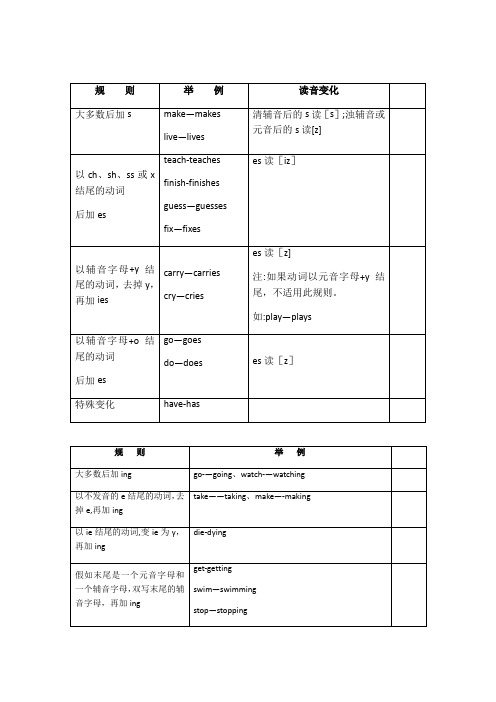
reused
plan
plans
planning
planned
planned
bite
bites
biting
bit
bitten
cheer
cheers
cheering
cheered
cheered
hit
hits
hitting
hit
hit
reach
reaches
reaching
reached
reached
listening
listened
listened
shout
shouts
shouting
shouted
shouted
eat
eats
eating
ate
eaten
talk
talks
talking
talked
talked
run
runs
running
ran
run
sleep
sleeps
sleeping
slept
looking
looked
looked
like
likes
liking
liked
liked
meet
meets
meeting
met
met
thank
thanks
thanking
thanked
thanked
have
has
having
had
had
make
makes
making
made
made/maken
play
小学英语动词第三人称单数

小学英语动词第三人称单数篇一:小学动词第三人称单数形式用法+练习一般现在时中的第三人称单数形式在一般现在时中,当主语是第三人称单数时,谓语动词要用第三人称单数形式,即常在动词原形后加-s或-es。
(一)什么是一般现在时?一般现在时的基本用法有哪些呢?【一般现在时的功能】1.表示事物或人物的特征、状态。
如:The sky is blue.天空是蓝色的。
2.表示经常性或习惯性的动作。
如:I get up at six every day.我每天六点起床。
3.表示客观现实。
如:The earth goes around the sun.地球绕着太阳转。
(二)哪些主语是第三人称单数? 现归纳总结如下:一、人称代词he, she, it是第三人称单数。
如:He likes watching TV. 他喜欢看电视。
he has lunch at twelve. 她十二点吃午餐。
It looks like a cat. 它看起来像只猫。
二、单个人名、地名或称呼作主语;是第三人称单数。
如:①Han Mei looks like her mother. 韩梅看起来像她的母亲。
②Bei jing is in China. 北京在中国。
③Uncle Wang often makes cakes. 王叔叔经常做蛋糕。
三、单数可数名词或"this / that / the+单数可数名词"作主语时,是第三人称单数。
如:①A horse is a useful animal. 马是有用的动物。
②This book is yours. 这本书是你的。
③That car is red. 那辆小汽车是红色的。
④The cat is Lucy's. 这只猫是露茜的。
四、不定代词someone, somebody, nobody, everything, something等及指示代词this,that作主语时,是第三人称单数。
- 1、下载文档前请自行甄别文档内容的完整性,平台不提供额外的编辑、内容补充、找答案等附加服务。
- 2、"仅部分预览"的文档,不可在线预览部分如存在完整性等问题,可反馈申请退款(可完整预览的文档不适用该条件!)。
- 3、如文档侵犯您的权益,请联系客服反馈,我们会尽快为您处理(人工客服工作时间:9:00-18:30)。
★第三人称单数动词的变化规则
③ 以辅音字母加y结尾的动词,先变y为i,再加 -es;
study --- studies worry --- worries
fly --- flies try ---tries
注:26个字母除了a, e, i, o, u为元音字母,其他的都 是辅音字母。
辅音字母 y 结尾,改y为i –es;
概念:表示经常性、习惯性的动作或存在的状态。 构成:主语+动词(be动词/行为动词)
★当主语是第三人称单数,动词要变成相应 的第三人称单数形式。
(The third person singular)
it
Amy
+行为动词
• Tom works (work) very hard. • She plays (play) the piano well.
★第三人称单数动词的变化规则
① 一般情况下,动词词尾直接加-s;
work --- works look --- looks make --- makes
play --- plays feel ---feels get --- gets
have --- has 通常词尾加-s,除了have变has;
4. Uncle Bill usually the evening. 5. The students 6. Zhaoqing
( fly ) kites on weekends. ( be ) a beautiful city.
一般现在时(The simple present tense)
★第三人称单数动词的变化规则
★第三人称单数动词的变化规则
② 以字母s, x, ch, sh, o结尾的动词,词尾加 上-es;
pass --- passes
teach --- teaches do --- does
fix --- fixes
wash ---washes
go --- goes
ch, sh, x, o, s,动词结尾-es;
★第三人称单数动词的变化规则口诀 一般现在时,主语三单变动词; 通常词尾加-s,除了have变has; ch, sh, x, o, s,动词结尾-es; 辅音字母 y 结尾,改y为i –es。
Let’s have a try.
1. My sister often 2. He 3. Andy go es has catches catch ( catch ) butterflies. ( go ) swimming with his friends. ( have ) a white cat. stay stays fly is ( stay ) athes (watch) TV on weekends. • He brushes (brush) teeth every day. • Sarah does (do) homework in the evening.
• The boy studies (study) English on Mondays. • It has (have) a big mouth.
一般现在时,主语三单变动词; 通常词尾加-s,除了have变has; ch, sh, x, o, s,动词结尾-es; 辅音字母 y 结尾,改y为i –es。
---动词“s”
一般现在时(The simple present tense)
★第三人称单数动词的变化规则
By Liang Ying (梁颖) 肇庆市第四小学
I like English.
You like English.
He likes English.
一般现在时(The simple present tense)
